Election-watching for the people
October 31, 2012
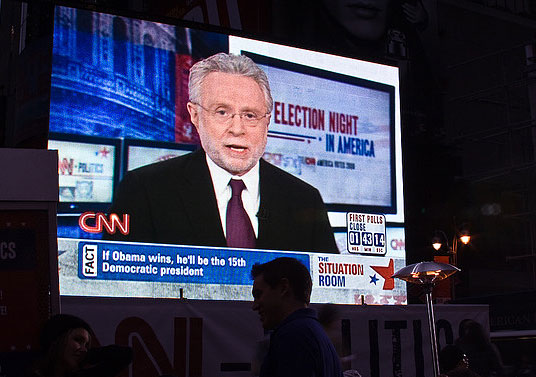
The 2008 big screen scene in N.Y.’s Times Square. Now it’s L.A.’s turn. Photo/Houry Najjarian via Flickr
Why watch the election from your living room when you can tune in from Los Angeles’s newly-remodeled civic core? Grand Park—nestled between City Hall and the County Hall of Administration—is throwing a free Election Night party, and everyone’s invited.
The event is being dubbed “Park Your Politics,” and the park’s director, Lucas Rivera, says it’s a chance to share a sense of history in a way that few people do anymore.
“We as Americans have stopped coming together in moments where we could see and witness something that changes the movement of this country,” said Rivera, adding that sharing the experience could make the outcome more enjoyable (or tolerable, depending on your outlook.)
CNN’s coverage of the 2012 Presidential election will be projected onto a huge 10-foot-by-30-foot inflatable screen, so every detail of Wolf Blitzer’s perfectly-manicured beard will be visible far and wide. While the results trickle in, guests will be entertained by music from KCRW’s Anthony Valadez and Dublab DJs. L.A.’s famed gourmet food trucks will keep hunger at bay and a beer garden will offer refreshments for the celebratory and weary alike.
The party takes place on the performance lawn between Grand Avenue and Hill Street on Tuesday, November 6, from 5 p.m. to 10 p.m. To get there, take Metro Red Line to the Civic Center stop or visit the park’s website for driving directions and parking instructions.
Posted 10/31/12
More than one way to cast a ballot
October 31, 2012
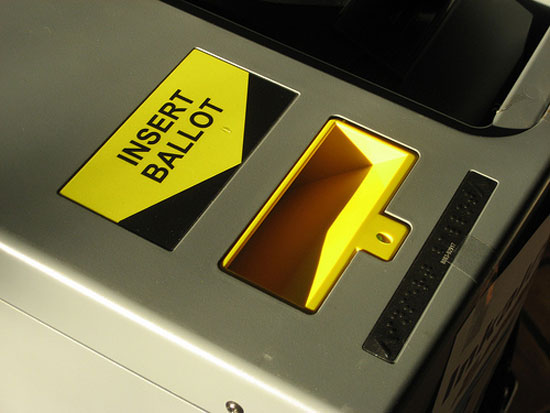
Whether you vote early or push it until right before the polls close, there's a way to make your voice heard.
Voting is not a spectator sport, and there’s no need for Los Angeles County residents to feel left out, even in a battleground-state-obsessed election like this one.
Early voting is getting lots of attention in other parts of the country, and you can do it here, too.
The Los Angeles County Registrar-Recorder’s office in Norwalk is open for early voting now through Election Day, with weekday hours from 8 a.m. to 5 p.m. and this Saturday and Sunday from 8 a.m. to 4 p.m. The address is 12400 Imperial Highway, Norwalk, 90650.
More than 1.2 million county voters requested absentee ballots for this election. If you haven’t mailed yours in yet, be sure to do so by Thursday, November 1; absentee ballots must be received (not just postmarked) by the time polls close on Election Day. If you’re in any doubt about making the deadline, just drop your ballot off in person at any polling place on Election Day.
Polls will be open on Tuesday, November 6, from 7 a.m. to 8 p.m. To find your polling place, go to www.lavote.net or call (800) 815-2666.
You can also check the same website to make sure you’re registered. If you’re one of the thousands who registered right before the deadline, your information may not have been entered into the system yet. Don’t worry! Find your polling place by clicking here, and go ahead and vote.
You will be offered a provisional ballot, which will be counted once your eligibility is verified.
“At this stage of the game, we’re encouraging people to just show up and vote,” said Registrar-Recorder/County Clerk Dean Logan. “If there’s an issue—if there were data entry errors in your form or if it was late getting to us—we can research those issues during the post-election canvass period. But if you don’t show up and vote we can’t fix it.”
He said that 90% of all provisional ballots in California are determined eligible and end up being counted.
Even with a tight presidential race whose outcome is likely to be determined elsewhere, casting a ballot here is vitally important, not only to contribute to the popular vote nationally but also to weigh in on important state and county measures, along with local races. With so many options, there’s really no good excuse not to vote.
“When people say your vote doesn’t count because you’re from California—well, it absolutely does count,” Logan said. “It has meaning and it’s important for you to show up and be counted.”
Posted 10/31/12
Look before you vote in Malibu
October 31, 2012
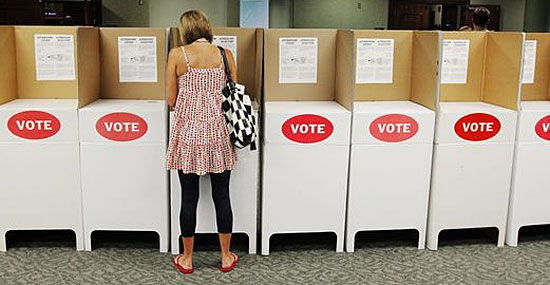
To avoid a mistake, voters in Malibu should rely on official county voting materials. Photo/L.A. Times
A voter information pamphlet published by the city of Santa Monica and sent to Malibu voters contains incorrect ballot position numbers for school board candidates and Measure ES, a bond measure seeking to fund improvements within the Santa Monica-Malibu Unified School District.
When marking their ballots, voters should consult only the official ballot materials issued by the Los Angeles County Registrar-Recorder, which are accurate.
This letter, from Santa Monica City Clerk Sarah Gorman, was sent to affected voters to explain the printing error. Gorman said that city staffers will also be out at polling places in Malibu in case questions arise on Election Day, Tuesday, November 6.
Posted 10/31/12
A shoe-in for taxpayers
October 31, 2012
It pays to put your best foot forward. Just ask the folks at the Department of Public Social Services.
Three years ago, DPSS discovered that it was losing nearly a million dollars a year, not to mention thousands of work hours, to slip-and-fall injuries in the workplace.
“We had individuals falling in parking lots, slipping in hallways, falling down the stairs, tripping over frayed carpet,” recalls Sherise McDowell-English, who handles risk management in the department’s human resources division. Mystified, they studied the data and interviewed managers in every bureau.
Finally, she recalls, they pinned down the problem: “People were coming to work in platform high heels and flip-flops.” The result? A Safe Shoe Campaign that last year saved the department more than $1.1 million and cut trip, slip and fall injuries by 23%.
That campaign is just one of more than 20 efforts, large and small, that are being honored this week at the county’s 26th Annual Productivity and Quality Awards. Because of Los Angeles County’s size, even seemingly modest improvements can make a huge difference, with results that go far beyond “attaboys” from bosses.
According to Chief Executive Officer William T Fujioka, award winners have garnered nearly $4 billion for the county in savings, cost avoidance and revenue since their inception a quarter-century ago. William A. Sullivan, who heads the county’s Quality and Productivity Commission, estimates that the county benefitted to the tune of nearly $170 million from the projects being lauded this year.
This year’s honorees (click here for a video sample) range from an iPhone app that allows county residents to request pothole repairs and easily follow their progress to a housing program that leveraged a $115 million county investment into a $551 million pool for the development of supportive housing for the homeless mentally ill. Here’s a look at some of the others:
- An efficiency project in the Registrar-Recorder/County Clerk’s Office that shortened the month-long wait for most certified copies of birth, death and marriage certificates to a week or less.
- A data mining program at the Department of Public Social Services that is expected to save the county tens of millions of dollars by using an algorithm to detect fraud among recipients of subsidized child care.
- Prescription improvements at the Department of Health Services that have helped some 22,000 uninsured patients qualify for free medications from pharmaceutical manufacturers and that have bar-coded medication to avoid lethal mix-ups at county pharmacies.
- Technological improvements that have increased child support collections by $10 million, improved workflow at the Alternate Public Defender’s Office, streamlined water billing at the Department of Public Works, helped the county avoid rehiring sub-par contractors and offered a one-stop jury duty portal to Superior Court jurors.
- Collaborations that have improved medical services for abused children, reduced recidivism among military veterans with substance abuse and mental health problems, saved millions by helping county general relief recipients qualify for federal SSI benefits and diverted homeless people around the Los Angeles County-USC Medical Center to an urgent care clinic for primary care, as opposed to the costlier emergency room.
- A first-in-the-nation clinic for the treatment of chagas, a parasitic disease that is one of the leading causes of heart failure among Latin American immigrants in L.A.
- A plan that vastly improved public access to last year’s redistricting process.
- A special forensics training program for U.S. Marines at the Coroner’s Office.
Several of the awards are for programs that have already been expanded. The project that streamlined the mail processing of vital records at the Registrar-Recorder/County Clerk’s Office, for instance, has already led to improvements in the processing of fictitious business registration, the scanning and recording of property documents and a search for ways to consolidate the office’s call centers, says Sandra Spencer, an elections programs coordinator who worked on the original project.
“Our feedback has been really great,” she adds. “We actually get letters and phone calls from people, thanking us.”
Meanwhile, at DPSS, slip-and-falls are no longer the No. 1 source of injuries. (It’s all about the pushing and pulling of heavy file drawers now, according to human resources workers.)
But McDowell-English says the colorful Safe Shoe fliers and posters will remain, to keep workers on their toes—and balanced. As for her own footwear, she says she sets a cautious example: “I wear ballerina flats to work.”
Posted 10/25/12
Young and online—but will they vote?
October 31, 2012
Voter registration in Los Angeles County is on a roll, with a surge in online registrations, particularly among young voters, helping to set new records leading up to the Nov. 6 presidential election.
The L.A. County electorate now stands at 4,674,338—larger than the registered voter population in 42 of the 50 states. Nearly one million of the county’s voters are under 30, and that’s the group that has most enthusiastically embraced online registration, according to figures released this week by the Registrar-Recorder/County Clerk.
In all, 284,268 people registered to vote or updated their registration information in September or October—and 42% of them did so online, the Registrar-Recorder’s analysis found. Of those, nearly half, or 56,980, were between the ages of 18 and 29. And 74% percent of those taking advantage of the online option were under 40.
“For a particular demographic…once it was turned on, they rushed to it,” Registrar-Recorder/County Clerk Dean Logan said. “It was sort of like an ‘if you build it, they will come’ type of scenario.”
Democrats, who make up half of the county’s electorate, were the most avid users of online registration (55.85%), followed by nonpartisans (22.34%) and Republicans (13.8%.) (Traditional, on-paper registration activity during the same September-October period was 57.45% Democratic, 26.37% nonpartisan and 10.83% Republican.)
The Registrar-Recorder also found that Los Angeles County is home to the largest permanent mail-in voting bloc in California, with more than one in four voters now registered to always cast their ballots by mail.
More than 1.2 million such ballots were requested for this election, and 461,322 had been returned as of Oct. 31. Of those, 50.81% came from voters who registered as Democrats, 29.74% by Republicans, and more than 16% by nonpartisan or “decline to state” voters. (Updated 11/2/12: By Thursday afternoon, 549,000 ballots had been returned—50.59% from those registered as Democrats, 29.65% from Republicans and nearly 17% from “decline to state” and nonpartisan voters.)
That breakdown is not surprising, given the political composition of the county electorate. Overall, the latest figures from Logan’s office show that it is 50% Democratic, 22% Republican and 19% “decline to state,” with 4% calling themselves nonpartisan and the rest belonging to various other political parties.
As it has statewide, the pool of registered voters in the county has grown to record levels. The Registrar-Recorder’s analysis shows a 9% jump in registration between 2008 and 2012, with 375,898 new voters added. That beats the historic registration numbers leading up to the 2008 presidential election; during the four-year period from 2004 to 2008, the county’s electorate increased by 8%.
Online registration—being offered for this first time this year—seems to be playing a key role in the increase.
Even Logan seemed surprised at the large volume of registration activity leading up Oct. 22, the deadline for registration.
On that day alone, 88,214 online voter transactions (including both new registrations and updates to existing registrations) were submitted.
“I’ve never seen anything quite like that. That was pretty remarkable,” Logan said.
It remains to be seen whether the newly registered younger voters, who have traditionally lagged behind their elders when it comes to casting ballots, will make their voices heard this Election Day. (The presidential election of 2008 was a big draw for younger voters, however, with 19.5% of 18-29-year-olds casting ballots in Los Angeles County, compared to 18.4% in 2004 and 15.8% in 2004.)
“It’s always encouraging to see an increased level of interest in participation,” Logan said this week. “Now the challenge, of course, for us from an administrative standpoint but also for stakeholders in the election process, is turning that interest in registration into getting those people out and actually having them cast their ballots.”
Read the entire report here.
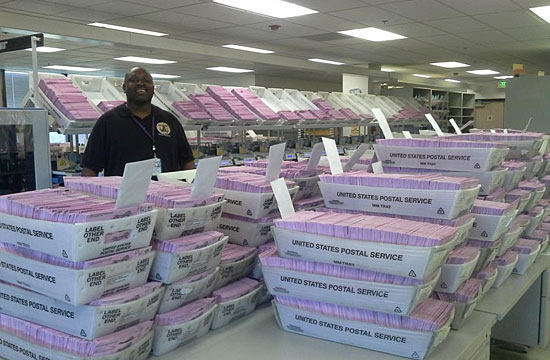
Temporary elections employee Rocky Williamson with some of the thousands of ballots already mailed in.
Posted 10/29/12
The mountains’ new king of the hill
October 30, 2012
In 1976, David Szymanski’s grandparents took him on a Bicentennial road trip across the United States.
“I was eight,” he remembers. “We stopped at the Badlands and Mt. Rushmore, Yellowstone, Hoover Dam, maybe the Grand Canyon. The landscapes of the Great Plains and the West were so different in so many ways from what I was used to. I remember coyotes yipping in Montana and Wyoming. It was spectacular. I was amazed that such places existed.”
That amazement stayed with him—as a teenager in the Rust Belt, as a University of Michigan engineering student and, in his senior year of college, in a random-but-career-altering class on the literature of the American wilderness that “dredged up everything I’d felt at eight.”
Now Szymanski, a 44-year-old veteran of the National Park Service, is managing of one of Southern California’s own spectacular places as the new superintendent of the Santa Monica Mountains National Recreation Area.
Szymanski was named after a 10-month search for a successor to the popular Woody Smeck, who was the public face of the nation’s largest urban national park for more than a decade before moving on to a job as a deputy superintendent at Yosemite National Park.
It’s a tough act to follow, acknowledges Szymanski, who was half-joking but completely awestruck when he referred to Smeck as “St. Woody” during a recent meet-and-greet with public officials. The 153,750-acre recreation area is a complex jurisdictional patchwork with players at every level of government as well as powerful community and nonprofit interests; as superintendent, Smeck worked on everything from preservation guidelines for sensitive wildlife habitat to firefighting policy to funding for thousands of acres of open space acquisitions.
“He’s a great, great, great, great person,” Symanski says.
Szymanski, however, brings his own set of credentials, including long experience in areas with complex issues requiring cooperative management. He has spent nearly two decades working with parks and protected areas, including 14 years in the National Park Service.
His most recent stint was as superintendent of the Lewis and Clark National Historic Park in the Pacific Northwest, but he also has served at Everglades National Park in Florida, Voyageurs National Park in Minnesota, on the Senate Subcommittee on National Parks as a congressional fellow and, in the 1990s, in Madagascar, working in that country’s then-new national park system.
“I’ve always enjoyed working in places where we’ve had to work with communities and partners to get things done,” he says. “At Lewis and Clark, we included several state parks in our boundaries, and in the Everglades, it was often sugar farmers against fishing guys, and finding solutions among people that often otherwise wouldn’t be in the same room. This is the best place in the country for those kinds of things.”
On the job for all of three weeks, Szymanski has already hit the ground hiking, reaching out to stakeholders and learning the landscape even as he settles in with his wife, Elaine, and their 6- and 8-year-old sons, and tries to squeeze in the occasional bike ride (he’s an avid cyclist.)
“I’ve hiked from Newbury Park up the Boney Mountain Trail. I’ve biked the Backbone Trail. I went to Solstice Canyon with the granddaughter of [grocery store magnate] Fred Roberts, who assembled so much of the canyon property and sold it into conservation. I met the neighbors at Zuma and Trancas Canyons, and went to a lot of smaller areas. Of course, I’ve spent time at the new Visitor Center at the King Gillette Ranch.”
On a recent afternoon, he strolled along the Inspiration Loop Trail near the Visitors’ Center, discussing ways to improve signage—a small-but-complex question, particularly for pet owners, since the 5-minute walk between the center and the unmarked trailhead traverses both National Park land (which allows dogs) and land overseen by the Mountains Restoration and Conservation Authority (where dogs are forbidden).
But the hike, led by NPS Park Guide Bethany McCormick, was also a lesson in the storied history of the property’s Hollywood origins and its stints as a retreat for various cults and religions. And midway through, it was interrupted by a family of five mule deer, who paused on the sun-dappled trail and then bounded away.
“The mountains in a way say so much about Los Angeles, about the people who came here to seek their fortune and then assembled this megalopolis,” says Szymanski. “But what’s also impressive to me is knowing that in 1978, most of the area was not protected. It’s really humbling in some ways because there are so many people here who are so active and with such a long list of accomplishment in this area. Our job, I think, is to continue that vision and to bring the resources we have at our disposal to that partnership.”
And, he adds, to hold onto our sense of amazement.
“My wife went out for a walk last week near where we’re staying, which is near Cheesboro and Palo Comado Canyons, and took a movie for our children, so they could hear the coyotes yipping in the background,” he marvels. “She was less than a half-mile from a residential area, and yet you had the sounds of the wild.”
Posted 10/30/12
Haunting with a homespun touch
October 24, 2012
In a world full of gory, glitzy theme park Halloween extravaganzas, a hand-crafted small town production would seem to have about as much chance of survival as an ingénue in the first reel of a slasher flick.
But for the second year, the resourceful Theatricum Botanicum in Topanga Canyon is staging a spirited fright-fest that’s more about old school creativity than slick effects.
At “Theatricum BOO-tanicum,” stage performers, business owners and residents of the famously artistic mountain community come together to conjure an eerie atmosphere without a ton of technology or expensive effects. Recycled theater sets and old netting are used to complement donated traditional decorations.
“We try to take a high-toned chill factor rather than a gore factor—a spookiness rather than severed heads,” says event organizer Matt van Winkle.
The setting helps. Craggy trees and old wooden structures form an ominous backdrop come nightfall, when the shadows stretch across the canyon.
The event may be the perfect destination for families, van Winkle said, noting that last year’s crowd included more children than expected. Peter Alsop will entertain with songs, and costumed theater company veterans will bring ghost stories to life. Kids and adults are encouraged to wear their costumes, with a contest scheduled to honor the best.
There are plenty of other attractions, like pumpkin carving, magicians, old school carnival games and an improv comedy performance by “Off The Grid,” a local troupe. In a nod to Los Angeles culture, chicken and waffles will be the featured menu item—all organic, of course.
Even with all the wholesome fun, the BOO-tanicum promises its fair share of shrieks, too. Van Winkle boasted that last year he got complaints from a few parents that the gore-free haunted house was “too scary.” There is also a haunted maze, and undead thespians will roam the grounds to keep visitors on their toes.
It all takes place Friday, October 26, from 2 p.m. to 10 p.m. The event is the fall fundraiser for the Theatricum, a nonprofit theater and center for the arts. Admission is $20 for adults, $15 for teens and $5 for kids ages 5 to 12. Children 4 and under are free. See the website for directions and, if you decide to go, keep an eye out for Zombie Shakespeare.
Posted 10/24/12
Spotlight’s on new El Cariso center
October 24, 2012
El Cariso Park’s new community center’s got game—15,000 square feet of it, including a state-of-the-art gymnasium, gleaming stainless steel kitchen, eco-friendly landscaping, and a main lobby adorned with three shimmering olive leaf sculptures suspended from above.
The $11.5 million project also includes a computer-equipped classroom and a multipurpose room. The gymnasium has two electronic scoreboards and can be divided so more than one game can take place at a time.
The new center significantly expands the recreational profile of the county regional park, which attracts 410,026 users each year and offers programs for young people, seniors and others that draw 8,326 annually.
The artwork in the lobby, by Venice sculptor Cliff Garten, was commissioned under the county’s Civic Art program. It pays tribute to the fabled olive groves of Sylmar, where the park is located.
The leaves in the sculpture are bronze, and the new building’s environmental certification is LEED Silver, all the way. The designation honors energy-efficient design and building methods.
Anticipation for the center’s opening is building in the neighborhood.
Juan Cisneros, who lives a few blocks from the park, is looking forward to enrolling his sons, Christian and Andrew, in basketball programs there, and perhaps volunteering as a coach himself.
“I already picked up some registration forms,” he said. “I was there yesterday. From the outside, it looks huge. Even my wife is excited to see the inside of the gym.”
Alina Mendizabal, a local activist and park volunteer, said the new facility represents a big step forward for the community.
“It’s brought Sylmar up another notch,” she said. “I’m really excited because it’s such a beautiful building. There are so many things we can do in there…The possibilities are endless.”
Dedication of the gymnasium and community center—a joint project of the 3rd Supervisorial District and the county departments of Parks and Recreation and Public Works—will take place at 10 a.m. on Saturday, Oct. 27. The park is located at 13100 Hubbard St., Sylmar, 91342.
If you can’t make the opening, or just can’t wait for a sneak peek, check out the gallery of images below.
Posted 10/24/12
For jobs’ sake, don’t stop Expo
October 23, 2012
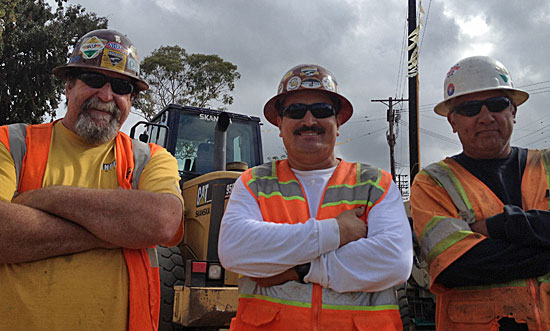
With 400 construction workers already building Expo Phase 2, a court-ordered stay would be devastating.
For more than a year, construction crews have been hard at work on the second leg of the Expo Line, building bridges that will separate trains from surface street traffic and laying the groundwork to extend the popular light rail line all the way to Santa Monica.
Some 400 construction workers are on the job today, along with more than 4,000 others whose work is directly or indirectly tied to the project.
But, with $300 million already spent on this urgently-needed $1.5 billion project, there’s an obstacle that’s suddenly threatening to stop Expo in its tracks.
While this light rail project enjoys widespread public support as an important transit alternative to the severely clogged 10 Freeway that runs alongside it, a small group in the neighborhood has been waging a long-running battle against Expo. Their arguments, challenging the project’s environmental review process, already have been rejected at the state trial and appellate court levels, and now are before the state Supreme Court.
I’m confident that the Expo Authority, which won at both the state trial and appellate court levels, will prevail again before the California Supreme Court. But in the interim, there’s a new and worrisome twist in the case: the challengers are asking the high court to issue a stay that would immediately shut down work on the project until the justices have decided the matter.
This week, I joined with other local officials in calling on the court to please keep the Expo project rolling forward without interruption.
Shutting down work at this juncture would be devastating on so many levels. Our recession-wracked region still has unemployment that’s way too high—and it’s even worse among construction workers.
Just ask Lawrence Douglas, a carpenter apprentice who just started working on Expo a month ago, after 14 months of looking for work. Or Tim White, a crane operator who’s also found work—but wonders whether the job will disappear abruptly in the next few weeks. Or Clementino Perez, a drilling supervisor who knows that each paycheck ripples out well beyond the individual who earns it: “We have a lot of people working over here, and if they shut us down, we’re going to be staying home. That affects the economics for all our families.”
And the impact doesn’t stop there. The county’s taxpayers, who are paying for the project with funds from the voter-approved Measure R, will see the tab go up by at least $90 million if there’s a court-ordered stop in construction. And the project would take at least a year longer to build—which is bad news for the tens of thousands who are looking forward to ditching their cars and riding the train each day. (Already, Expo’s first segment, from downtown Los Angeles to Culver City, is attracting 20,000 riders a day, and growing.)
Attorneys representing the Expo Line recently filed papers with the California Supreme Court strongly opposing the neighborhood group’s motion for a stay. I believe their arguments are extremely persuasive, and that the high court will see the importance of keeping this project moving forward even while the case as a whole is under review.
But I also think that this issue is too important to be left just to the lawyers. Everyone in Los Angeles has a stake in this project.
Let’s keep Expo on track to open all the way to Santa Monica by 2015, and please, let’s keep construction workers out of the unemployment lines and out on the front lines of building a better transit future for all of us.
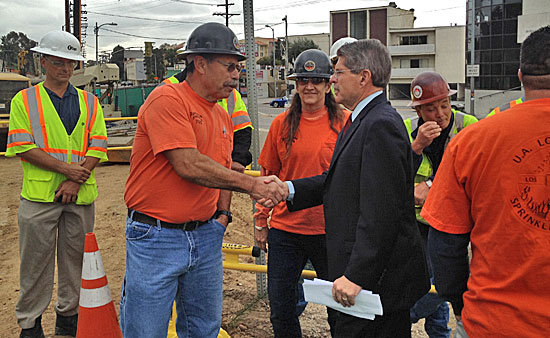
Supervisor Yaroslavsky greets workers this week at the future site of Expo's National/Palms station.
Posted 10/23/12




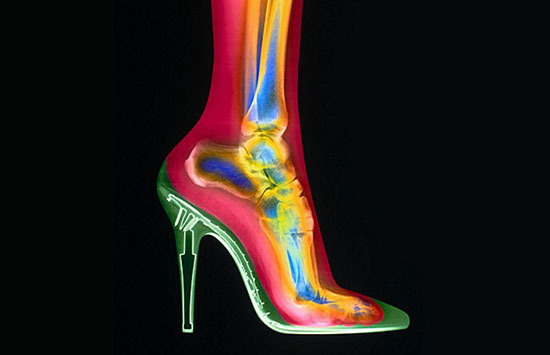

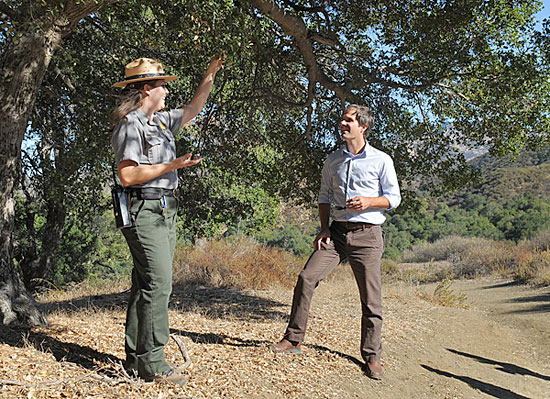


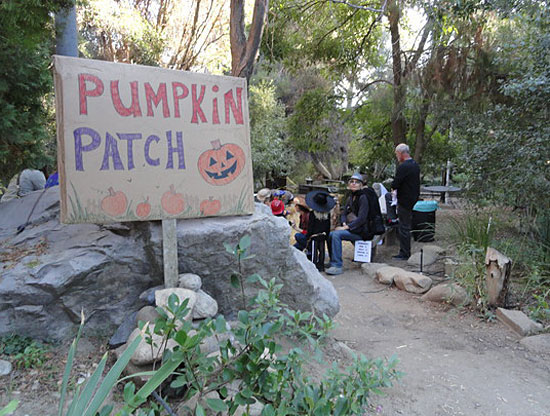

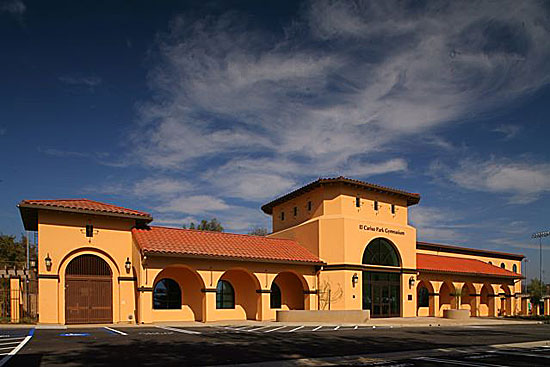










 Check for the latest closure information
Check for the latest closure information








